Themed collection Fluorine

Fluorine
Welcome to this themed issue of Dalton Transactions entitled ‘Fluorine’.

Dalton Trans., 2015,44, 19409-19410
https://doi.org/10.1039/C5DT90180D
Gold trifluoromethyl complexes
This Perspective reviews the synthesis, structure, reactivity and applications of gold trifluoromethyl complexes. The recently reported reactions of gold(III) trifluoromethyl complexes with potential application in synthesis are discussed.
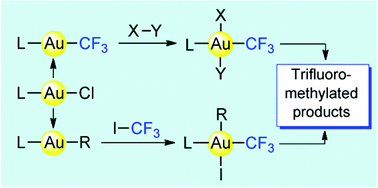
Dalton Trans., 2015,44, 19432-19442
https://doi.org/10.1039/C5DT02023A
The non-aqueous fluorolytic sol–gel synthesis of nanoscaled metal fluorides
Nanoscopic metal fluorides with new applications.
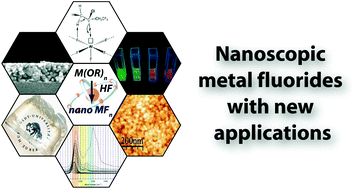
Dalton Trans., 2015,44, 19411-19431
https://doi.org/10.1039/C5DT00914F
Chemo-, regio-, and stereo-selective perfluoroalkylations by a Grignard complex with zirconocene
The unique reactivity and high selectivity of the zirconocene-hybridized heterobimetallic perfluoalkyl Grignard reagents can be employed for efficient and highly selective nucleophilic perfluoroalkylation of carbonyl compounds and epoxides, in particular.
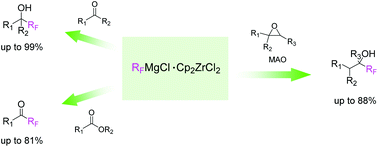
Dalton Trans., 2015,44, 19464-19468
https://doi.org/10.1039/C5DT03039K
Catalytic defluorinative [3 + 2] cycloaddition of trifluoromethylalkenes with alkynes via reduction of nickel(II) fluoride species
A catalytic synthesis of 2-fluoro-1,3-cyclopentadienes was achieved via [3 + 2] cycloaddition of 2-trifluoromethyl-1-alkenes and alkynes using a nickel catalyst and a diboron-based ternary additive system.
![Graphical abstract: Catalytic defluorinative [3 + 2] cycloaddition of trifluoromethylalkenes with alkynes via reduction of nickel(ii) fluoride species](/en/Image/Get?imageInfo.ImageType=GA&imageInfo.ImageIdentifier.ManuscriptID=C5DT02160J&imageInfo.ImageIdentifier.Year=2015)
Dalton Trans., 2015,44, 19460-19463
https://doi.org/10.1039/C5DT02160J
Reactions of allyl alcohols and boronic acids with trifluoromethanesulfonyl hypervalent iodonium ylide under copper-catalysis
Trifluoromethylsulfinyl 3 and trifluoromethylthio 5 compounds are independently obtained by using the sulfone-type reagent 1 under Cu catalysis.

Dalton Trans., 2015,44, 19456-19459
https://doi.org/10.1039/C5DT02214B
Synthesis and optical properties of subphthalocyanine homo- and heterodimers axially connected via a hydroquinone linker
The electron transfer process between subphthalocyanines differs depending on the o-, m-, and p-geometries of the hydroquinone linker.
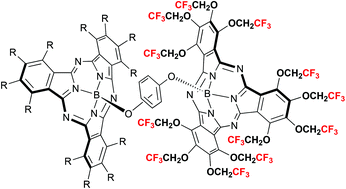
Dalton Trans., 2015,44, 19451-19455
https://doi.org/10.1039/C5DT02279G
Organotrifluoroborates as attractive self-assembling systems: the case of bifunctional dipotassium phenylene-1,4-bis(trifluoroborate)
A multitude of non-covalent interactions, investigated by X-ray crystallography and computational chemistry techniques, proved to be responsible of the spontaneous self-assembly of a bis(trifluoroborate) dipotassium salt.
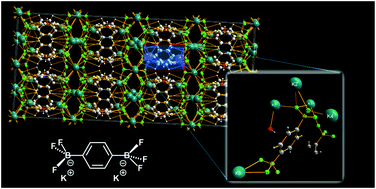
Dalton Trans., 2015,44, 19447-19450
https://doi.org/10.1039/C5DT02020D
Accessing perfluoroalkyl nickel(II), (III), and (IV) complexes bearing a readily attached [C4F8] ligand
The [C4F8] ligand supports a family of related fluoroalkyl nickel complexes spanning the +2 to +4 oxidation states.
![Graphical abstract: Accessing perfluoroalkyl nickel(ii), (iii), and (iv) complexes bearing a readily attached [C4F8] ligand](/en/Image/Get?imageInfo.ImageType=GA&imageInfo.ImageIdentifier.ManuscriptID=C5DT01771H&imageInfo.ImageIdentifier.Year=2015)
Dalton Trans., 2015,44, 19443-19446
https://doi.org/10.1039/C5DT01771H
Supramolecular aggregation of Ni(salen) with (C6F5)2Hg and [o-C6F4Hg]3
Organomercurials (C6F5)2Hg and [o-C6F4Hg]3 interact with Ni(II)-salen to form adducts held by arene-perfluoroarene and hydrogen bonding interactions, as well as interactions between Hg, the salen ligand, and Ni.
![Graphical abstract: Supramolecular aggregation of Ni(salen) with (C6F5)2Hg and [o-C6F4Hg]3](/en/Image/Get?imageInfo.ImageType=GA&imageInfo.ImageIdentifier.ManuscriptID=C5DT01887K&imageInfo.ImageIdentifier.Year=2016)
Dalton Trans., 2016,45, 5045-5051
https://doi.org/10.1039/C5DT01887K
A combined quantum-chemical and matrix-isolation study on molecular manganese fluorides
Molecular manganese fluorides were studied in solid neon, argon and fluorine using IR spectroscopy and quantum-chemical calculations at DFT and CCSD(T) levels.
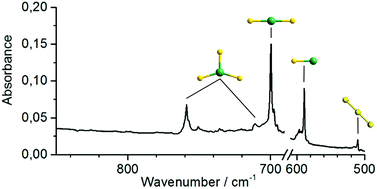
Dalton Trans., 2016,45, 5038-5044
https://doi.org/10.1039/C5DT04827C
A fluorosurfactant and photoreducible CuII-tren click catalyst: surfactant and catalytic properties at liquid/liquid interfaces
The fluorous copper(II)-tren complex 2 is a powerful surfactant which strongly reduces the perfluorodecalin/water and diisopropyl ether/water interface tensions. When photoreduced by light it catalyzes the Huisgen click cycloaddition.
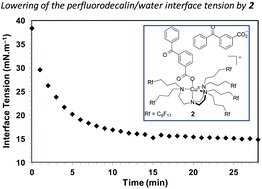
Dalton Trans., 2015,44, 19700-19707
https://doi.org/10.1039/C5DT02039E
Approaches to prepare perfluoroalkyl and pentafluorophenyl copper couples for cross-coupling reactions with organohalogen compounds
Synthesis of perfluoroorgano copper lithium and silver couples.

Dalton Trans., 2015,44, 19693-19699
https://doi.org/10.1039/C5DT02925B
Functionalization of Zr-based MOFs with alkyl and perfluoroalkyl groups: the effect on the water sorption behavior
The influence of organic functional groups (fluorinated versus non-fluorinated) on the hydrophilic/hydrophobic balance of MOFs has been studied.
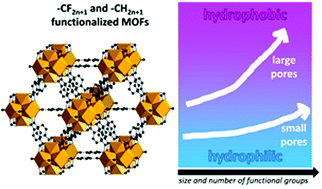
Dalton Trans., 2015,44, 19687-19692
https://doi.org/10.1039/C5DT02908B
Iron-catalyzed electrochemical C–H perfluoroalkylation of arenes
A new iron-catalyzed reaction for the coupling of perfluoroalkyl iodides with aromatic substrates is described.
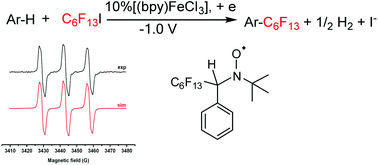
Dalton Trans., 2015,44, 19674-19681
https://doi.org/10.1039/C5DT03009A
Optimisation of a sol–gel synthesis route for the preparation of MgF2 particles for a large scale coating process
Preparation of transparent and low viscous MgF2 sols via sol–gel technique which can be applied for antireflective coatings on glass substrates is described.
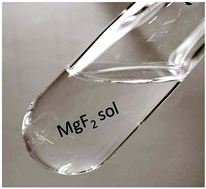
Dalton Trans., 2015,44, 19501-19508
https://doi.org/10.1039/C5DT02196K
Brønsted acid-promoted C–F bond activation in [P,S]-ligated neutral and anionic perfluoronickelacyclopentanes
Bidentate phosphinothiol ligand induces C–F bond functionalization in perfluoronickelacycles.
![Graphical abstract: Brønsted acid-promoted C–F bond activation in [P,S]-ligated neutral and anionic perfluoronickelacyclopentanes](/en/Image/Get?imageInfo.ImageType=GA&imageInfo.ImageIdentifier.ManuscriptID=C5DT02912K&imageInfo.ImageIdentifier.Year=2015)
Dalton Trans., 2015,44, 19587-19596
https://doi.org/10.1039/C5DT02912K
Structure investigations on oxygen fluorides
The solid state structures of O2F2 and OF2 resemble those in the gaseous state. Attempts to isolate the proposed (O2+)2PdF62− from O2F in HF result in the formation of (O2+H3Pd2F12−)n.
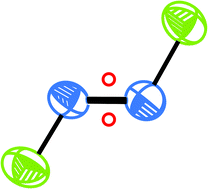
Dalton Trans., 2015,44, 19659-19662
https://doi.org/10.1039/C5DT02247A
Transition metal complexes bearing NHC ligands substituted with secondary polyfluoroalkyl groups
Silver and palladium complexes bearing dihydroimidazolylidene or imidazolidinylidene NHC ligands substituted with racemic secondary polyfluoroalkyl groups were synthesized.
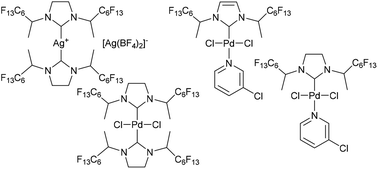
Dalton Trans., 2015,44, 19663-19673
https://doi.org/10.1039/C5DT02258D
Reactivity of platinum alkyne complexes towards N-fluorobenzenesulfonimide: formation of platinum compounds bearing a β-fluorovinyl ligand
Fluorination reactions at platinum(0) alkyne complexes with N-fluorobenzenesulfonimide (NFSI) occur either at the metal centre or at the metal bound alkyne to give β-fluorovinyl complexes.

Dalton Trans., 2015,44, 19553-19565
https://doi.org/10.1039/C5DT02306H
The structure of trimethyltin fluoride
Contrary to previous reports, trimethyltin fluoride was shown to adopt a linear chain structure with symmetric fluorine bridges in the solid state.
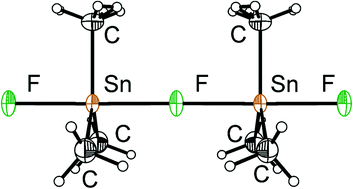
Dalton Trans., 2015,44, 19651-19658
https://doi.org/10.1039/C5DT01994J
Isocyanate deinsertion from κ1-O amidates: facile access to perfluoroaryl rhodium(I) complexes
Perfluorophenyl-subsituted amidates undergo unprecedented C6F5 migration to Rh(I) on heating, providing a new route to Rh-C6F5 organometallic fragments.

Dalton Trans., 2015,44, 19487-19493
https://doi.org/10.1039/C5DT01981H
Salts of highly fluorinated weakly coordinating anions as versatile precursors towards hydrogen storage materials
Metathetic reactions using salts of highly-fluorinated weakly coordinating anions permit synthesis of high-purity hydrogen storage materials.
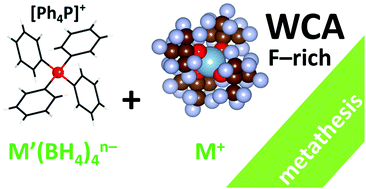
Dalton Trans., 2015,44, 19469-19477
https://doi.org/10.1039/C5DT02005K
Highly electron-poor Buchwald-type ligand: application for Pd-catalysed direct arylation of thiophene derivatives and theoretical consideration of the secondary Pd0–arene interaction
Highly electron-poor SPhos ligands stabilised the Pd complex by secondary Pd0–arene interaction.
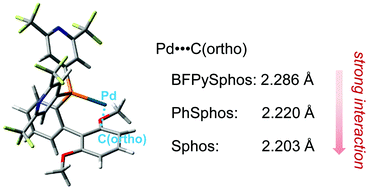
Dalton Trans., 2015,44, 19642-19650
https://doi.org/10.1039/C5DT01991E
Phase and redox shifted four iron/four sulfur clusters: fluorous analogs of metalloenzyme cofactors
The title compounds, [Q]2[Fe4S4(S(CH2)nRf8)4], feature dianions with four fluorous thiolate ligands and cations that are non-fluorous, “light fluorous”, or “heavy fluorous”; fluorous/organic partition coefficients can reach >93 : <7.
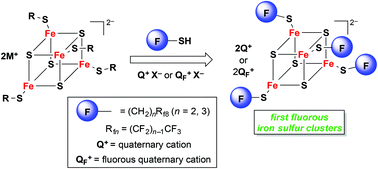
Dalton Trans., 2015,44, 19615-19624
https://doi.org/10.1039/C5DT01959A
Perfluoropropenyl-containing phosphines from HFC replacements
From HFC replacements CF3CF2CH2F and Z-CF3CF![[double bond, length as m-dash]](https://www.rsc.org/images/entities/char_e001.gif) CFH new E-perfluoropropenyl phosphine ligands are prepared, including the first perfluoroalkenyl bidentate phosphine, (E-CF3CF
CFH new E-perfluoropropenyl phosphine ligands are prepared, including the first perfluoroalkenyl bidentate phosphine, (E-CF3CF![[double bond, length as m-dash]](https://www.rsc.org/images/entities/char_e001.gif) CF)2PCH2CH2(E-CF
CF)2PCH2CH2(E-CF![[double bond, length as m-dash]](https://www.rsc.org/images/entities/char_e001.gif) CFCF3)2.
CFCF3)2.
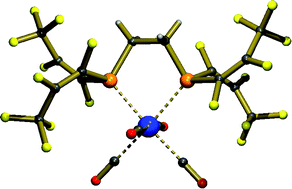
Dalton Trans., 2015,44, 19717-19731
https://doi.org/10.1039/C5DT02043C
What causes the weakest host to act as the strongest one? A theoretical study on the host–guest chemistry of five azacryptands and fluoride anions
Among five studied hosts, the one having the lowest attractive interaction with a fluoride anion shows the highest selectivity in solution due to reduced solvent hindrance.
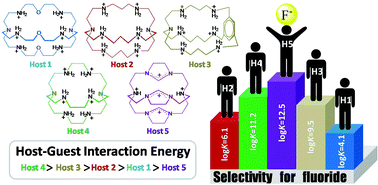
Dalton Trans., 2015,44, 19708-19716
https://doi.org/10.1039/C5DT01965F
Fluoride solid electrolytes: investigation of the tysonite-type solid solutions La1−xBaxF3−x (x < 0.15)
La1−xBaxF3−x solid solutions for x < 0.15 were prepared by solid state synthesis in a platinum tube under an nitrogen atmosphere with subsequent quenching for 0.07 ≤ x < 0.15.
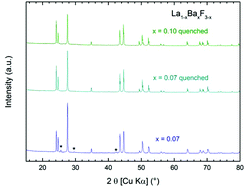
Dalton Trans., 2015,44, 19625-19635
https://doi.org/10.1039/C5DT02321A
AgPO2F2 and Ag9(PO2F2)14: the first Ag(I) and Ag(I)/Ag(II) difluorophosphates with complex crystal structures
Detailed characterization is presented of novel AgPO2F2 and AgI4AgII5(PO2F2)14 salts including their complex crystal structures and thermal decomposition.
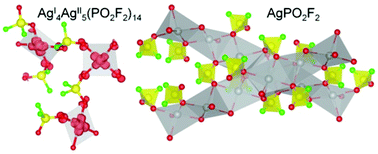
Dalton Trans., 2015,44, 19478-19486
https://doi.org/10.1039/C5DT02004B
Brønsted acid-catalyzed 1,2-fluorine migration with fluoroepoxides
An efficient 1,2-fluorine migration reaction was realized under Brønsted acid catalysis in the absence of an external fluorinating source. The high fluorine atom economy and very mild conditions make this reaction a promising protocol for the construction of the C–F bond.

Dalton Trans., 2015,44, 19636-19641
https://doi.org/10.1039/C5DT02088C
Synthesis, structure, and reactivity of iridium perfluorocarbene complexes: regio- and stereo-specific addition of HCl across a metal carbon double bond
Addition of HCl to perfluorocarbene complexes of iridium occurs regiospecifically and stereospecifically.
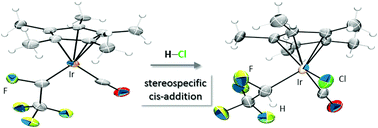
Dalton Trans., 2015,44, 19528-19542
https://doi.org/10.1039/C5DT02275D
C–F sp2 bond functionalization mediated by niobium complexes
The functionalization of fluorobenzene is described via insertion of isocyanide after the oxidative addition of the C–F bond.

Dalton Trans., 2015,44, 19494-19500
https://doi.org/10.1039/C5DT02082D
Stoichiometric and catalytic C–F bond activation by the trans-dihydride NHC complex [Ru(IEt2Me2)2(PPh3)2H2] (IEt2Me2 = 1,3-diethyl-4,5-dimethylimidazol-2-ylidene)
Multiple catalytic hydrodefluorination steps take place with the trans-dihydride complex [Ru(IEt2Me2)2(PPh3)2H2] (1), taking C6F6 to tri-, di- and mono-fluorobenzenes.
![Graphical abstract: Stoichiometric and catalytic C–F bond activation by the trans-dihydride NHC complex [Ru(IEt2Me2)2(PPh3)2H2] (IEt2Me2 = 1,3-diethyl-4,5-dimethylimidazol-2-ylidene)](/en/Image/Get?imageInfo.ImageType=GA&imageInfo.ImageIdentifier.ManuscriptID=C5DT01996F&imageInfo.ImageIdentifier.Year=2015)
Dalton Trans., 2015,44, 19597-19605
https://doi.org/10.1039/C5DT01996F
Axial fluoride binding by lanthanide DTMA complexes alters the local crystal field, resulting in dramatic spectroscopic changes
Dramatic changes are observed in both the NMR and luminescence spectra of LnDTMA complexes on addition of fluoride, consistent with a change in the nature of the magnetic anisotropy at the paramagnetic lanthanide centre.
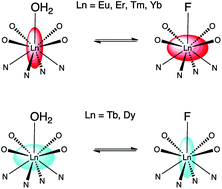
Dalton Trans., 2015,44, 19509-19517
https://doi.org/10.1039/C5DT02398J
Kinetico-mechanistic studies on the formation of seven-membered [C,N]-platinacycles: the effect of methyl or fluoro substituents on the aryl ancillary ligands
The rate determining step for the formation of seven-membered platinacycles from cyclometallated Pt(IV) aryl complexes is determined by the nature of the substituents on the aryl groups.
![Graphical abstract: Kinetico-mechanistic studies on the formation of seven-membered [C,N]-platinacycles: the effect of methyl or fluoro substituents on the aryl ancillary ligands](/en/Image/Get?imageInfo.ImageType=GA&imageInfo.ImageIdentifier.ManuscriptID=C5DT01926E&imageInfo.ImageIdentifier.Year=2015)
Dalton Trans., 2015,44, 19543-19552
https://doi.org/10.1039/C5DT01926E
Synthesis of new asymmetric substituted boron amidines – reactions with CO and transfer hydrogenations of phenylacetylene
Formation of amidine–BH(C6F5)2 adducts and their thermal dehydrogenation, CO uptake to form five-membered cyclic compounds and stoichiometric transfer hydrogenation toward phenylacetylene.

Dalton Trans., 2015,44, 19606-19614
https://doi.org/10.1039/C5DT01966D
Polyfluorinated carba-closo-dodecaboranes with amino and ammonio substituents bonded to boron
The three isoelectronic inner salts 1-H-x-H3N-closo-1-CB11F10 (x = 12, 7, 2) are accessible by fluorination of x-H3N-closo-1-CB11H11 (x = 12, 2) and 7-H3N-12-F-closo-1-CB11H10, respectively. Deprotonation of the decafluorinated ammoniocarba-closo-dodecaboranes yields the corresponding aminocarba-closo-dodecaborate anions [1-H-x-H2N-closo-1-CB11F10]− (x = 12, 7, 2).
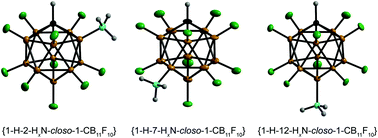
Dalton Trans., 2015,44, 19576-19586
https://doi.org/10.1039/C5DT02055G
A (pentafluoroethyl)(trifluoromethyl)carbene complex of iridium and reductive activation of its sp3 α, β, and γ carbon–fluorine bonds to give perfluoro-2-butyne, perfluoro-1,2,3-butatriene and perfluoro-1-irida-2-methyl-2-cyclobutene) complexes
Inner-sphere reduction of a (pentafluoroethyl)(trifluoromethyl)carbene ligand affords perfluorobutyne, perfluorobutatriene and perfluorometallacyclobutene ligands.
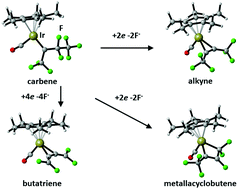
Dalton Trans., 2015,44, 19518-19527
https://doi.org/10.1039/C5DT02075A
P-Trifluoromethyl ligands derived from Josiphos in the Ir-catalysed hydrogenation of 3,4-dihydroisoquinoline hydrochlorides
Ferrocenyl phosphines containing a stereogenic P-CF3 group show improved selectivities in the Ir-catalysed hydrogenation of dihydroisoquinolinium derivatives.
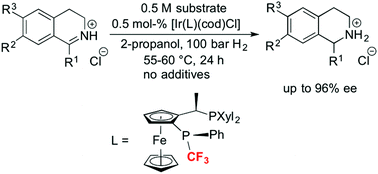
Dalton Trans., 2015,44, 19566-19575
https://doi.org/10.1039/C5DT02019K
Aryl-BIAN-ligated silver(I) trifluoromethoxide complex
The complex (Aryl-BIAN)AgOCF3 has been synthesised and structurally characterised. The reactivity towards trifluoromethoxylation of benzyl bromides has also been examined.

Dalton Trans., 2015,44, 19682-19686
https://doi.org/10.1039/C5DT02078F
About this collection
Guest Edited by Professor Jennifer Love (University of British Columbia), this issue focuses on all applications of fluorine in inorganic chemistry, including: organometallic and coordination complexes using fluorinated ligands, metal-catalysed and metal-mediated fluorination and C–F activation reactions, main group fluoride compounds, solid state metal fluorides, molecular fluoride complexes and materials for fluoride sensing and anion binding.